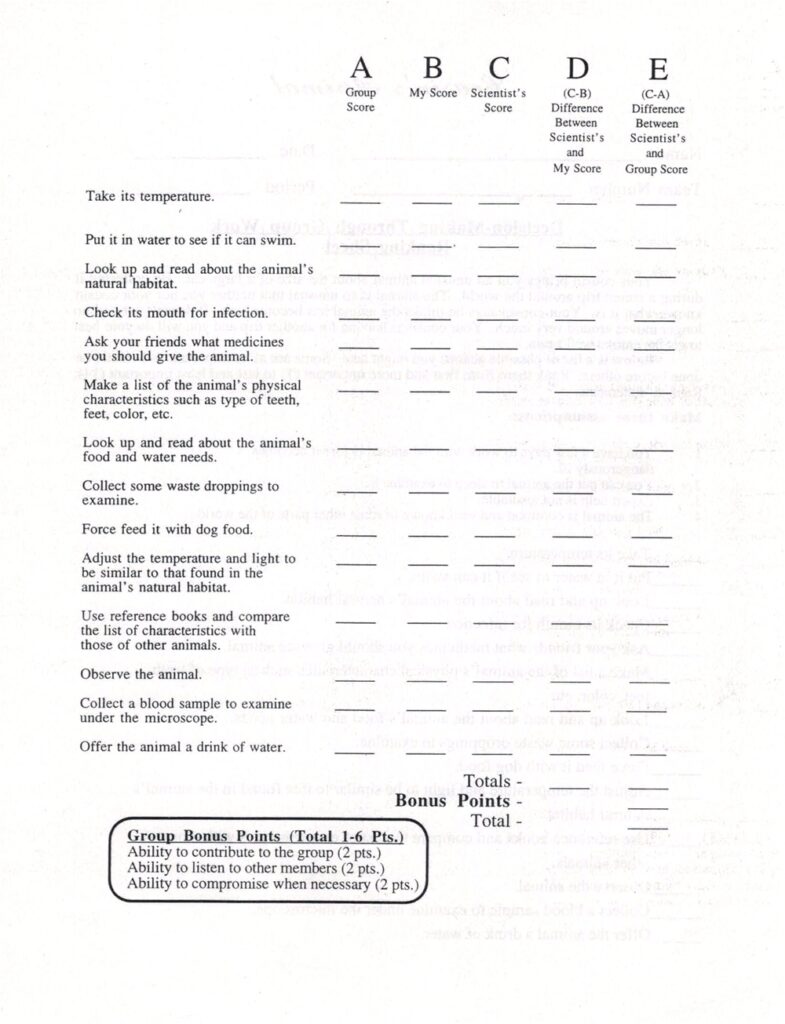
Decision-Making Through Group ‘Work … Rankings Sheet
Your cousin brings you an unusual animal about the size of a large cat. He collected it during a recent trip around the world. The animal is so unusual that neither you nor your cousin knows what it is. Your cousin says he think§ the animal has become sick. It doesn’t eat and no longer moves around very much. Your cousin is leaving for another trip, and you will do your best to get the animal well again.
Below is a list of possible actions you might take. Some are more important and should be done before others. Rank them from first and more important (1) to last and least important (14). Rank all statements.
Make these assumptions:
1. You have a few days to work with the animal before it becomes
dangerously ill.
2. You can put the animal to sleep to examine it.
3. Expert help is not available.
4. The animal is common and well known in some other parts of the world.
__________ Take its temperature.
__________ Put it in water to see if it can swim.
__________ Look up and read about the animal’s natural habitat.
__________ Check its mouth for infection.
__________ Ask your friends what medicines you should give the animal.
__________ Make a list of the animal’s physical characteristics such as type of teeth, feet, color, etc.
__________ Look up and read about the animal’s food and water needs.
__________ Collect some waste droppings to examine.
__________ Force feed it with dog food.
__________ Adjust the temperature and light to be similar to that found in the animal’s natural habitat.
__________ Use reference books and compare the list of characteristics with those of other animals.
__________ Observe the animal.
__________ Collect a blood sample to examine under the microscope.
__________ Offer the animal a drink of water.

OBSERVE / WATER … 1-2
INFORMATION … 3-6
COMFORT … 7
ACTIONS TO DIAGNOSE ILLNESS … 8-11
SCIENTISTS WOULD NOT USE … 12-14
Decision-Making Through Group ‘Work … Scoring Key
8 Take its temperature. / May provide information relating to the possible illness.
14 Put it in water to see if it can swim. / Does not provide useful information.
5 Look up and read about the animal’s natural habitat. / Provides necessary information so that animal can be put into a compatible environment.
9 Check its mouth for infection. / An easily performed action which may quickly provide information related to the possible illness.
13 Ask your friends what medicine you should give the animal. / Assuming your friends do not have an expert knowledge (assumption 3, expert help is available this is probably not useful)
3 Make a list of the animal’s physical characteristics such as type of teeth, feet, color, etc. / Provide information necessary for identification of the animal.
6 Look and read : out the animal’s food and water needs. / Provides information necessary for identification of the animal.
10 Collect some waste droppings to examine. / May provide information relating to possible illness.
12 Force feed it with dog food. / Probably not useful, may satisfy food requirements.
7 Adjust the temperature and light to be similar to that found in the animals natural habitat. / Acting on information in step 4.
4 Use reference books and compare the list of characteristics with those of other animals.
1 Observe the animal. / Only by observing the animal’s characteristics and behaviors is proper identification of the animal and any abnormalities in its characteristics and behaviors possible.
11 Collect a blood sample to examine under the microscope. / A more difficult and time consuming action (than steps 8 or 10), it may provide information relating to the possible illness.
2 Offer the animal a drink of water. / Adequate water is basic to survival, can be easily offered, and be available while other actions are preformed. There is no reason to assume water would have an adverse effect, so this step should not be delayed.